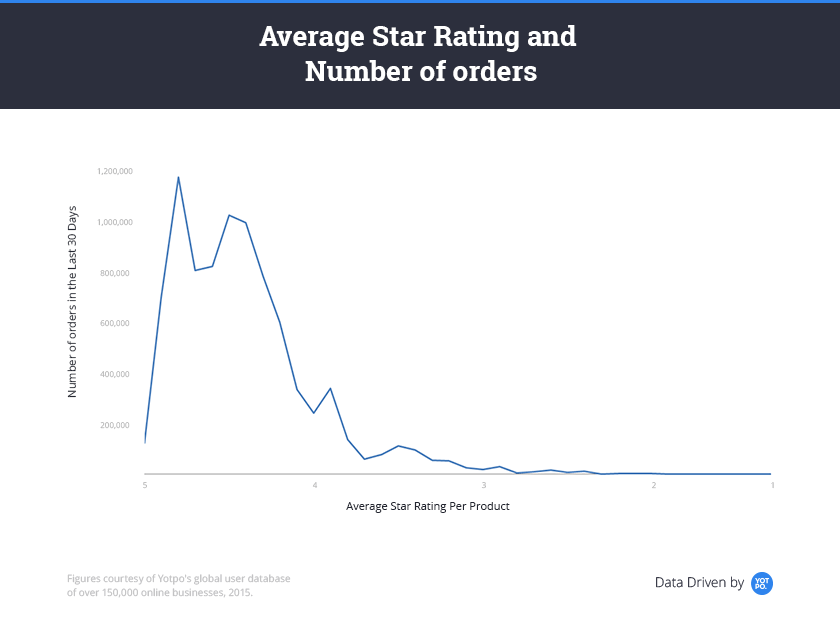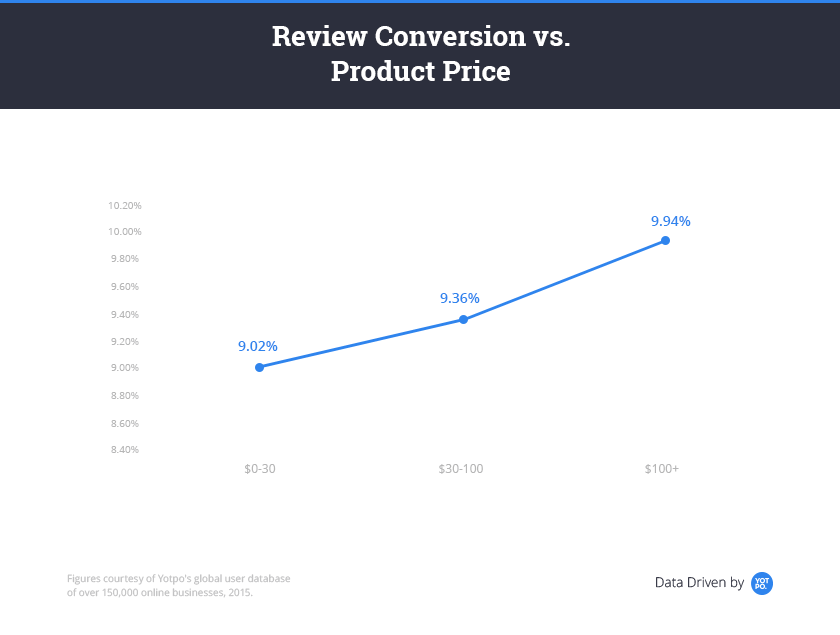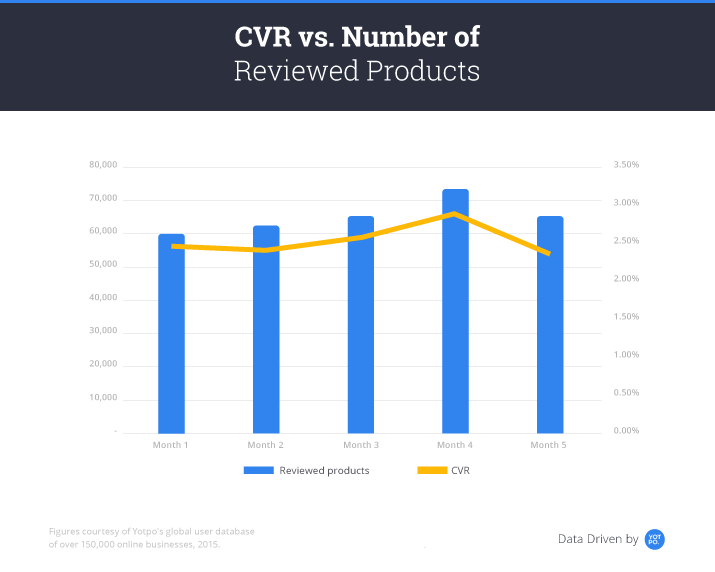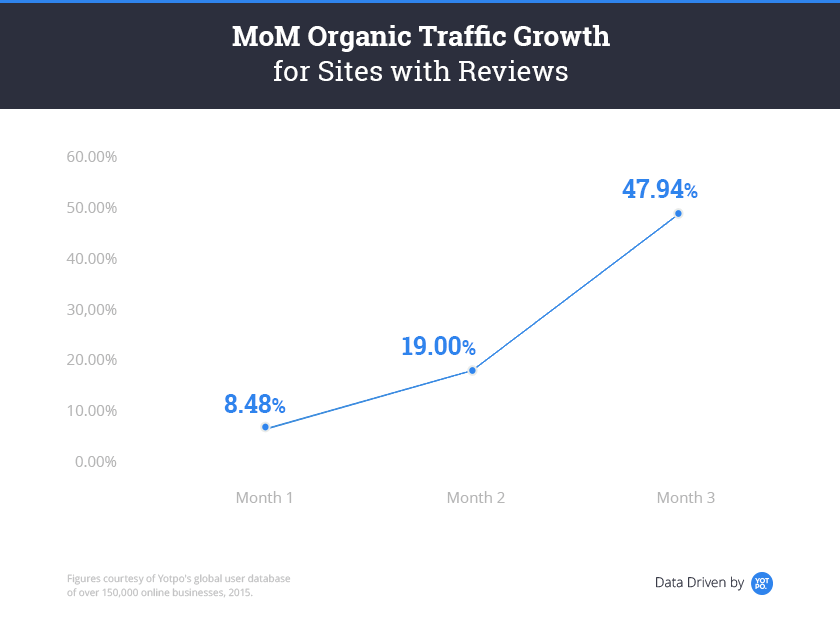Reviews convert.
But there are many factors that influence how reviews will affect your sales.
You may not be able to control everything about the reviews you receive — you can’t, for instance, demand a certain star rating — but there are plenty of ways you can smartly use the reviews you get to drive more sales.
How?
We took a look at data from over 150,000 eCommerce stores using reviews to identify when product reviews lead to the most sales.
The biggest takeaway? It’s not enough to just have reviews.
Brands that are getting ahead of the curve understand the importance of approaching reviews in a strategic way.
Here are some conclusions we reached after looking at the data about how you can create strategies to increase sales from reviews.
#1: Review Quantity and Quality Impacts Conversion
Clearly, five-star reviews are more likely to drive purchases than one-star reviews. But just how much does the number of stars make a difference?
Data comparing average star rating per product and number of orders stores receive shows just 4% of purchases are made for products whose overall rating is less than 3 stars.

So the majority of purchases happen for products with 4 or more stars. But even here, there are big differences in sales.
Products that have an average rating of 4-stars receive nearly 12 times more orders than those with an average rating of 3 stars. Products with an average rating of 5 stars have 126% more orders than those with 4 stars.
This shows that total star rating can make or break your business.
If you’re thinking this means you shouldn’t show any negative reviews, you’re wrong — negative product reviews can actually help you sell more.
People don’t trust stores that have only perfect reviews. Shoppers are more inclined to purchase when they see negative reviews and can understand the cause for the low rating. They may be able to put up with slow delivery, but if the product stops working after a month, that could put them off from buying.
Brands should display negative reviews and respond to them in order to build trust with customers.
But what about negative reviews impacting your sales? In order to dilute their effect, you need to get more overall reviews so the total score will be good.
Okay, so that gives us another issue: how do you get more reviews? Which leads to our next conclusion…
#2: Not All Products Are Reviewed Equally
There’s plenty of things you can do on your end to get more reviews. You can encourage customers to write reviews by making it easy for them to write and submit, asking for customer reviews on the right product at the right time, and asking effectively.
But not all products are reviewed equally. For one, the data shows people write more reviews on products that are highly rated.
Also, people also write more reviews for expensive products. As you can see in the graph below, the more expensive the product, the higher the review conversion rate.

People seem to be more likely to write reviews for items they see as highly valuable – whether it’s because they were primed to think the product was great because it had good reviews, or because they spent more money on the product.
In order to get reviews for products that are less expensive or don’t currently have a great review score, learn how to get more reviews for products no one wants to review.
#3: Review Distribution: You Need A Few Reviews on Each Product
Conversion rate is also dependent on how many of your total products have reviews, as well as how frequently you get new reviews. Stores should be aiming to consistently get new reviews on a wide variety of products. This signals to shoppers that your products are relevant and the reviews are recent and accurate.
Take a look below at how conversion rate correlates to the amount of newly reviewed products.

This is also important when considering an often overlooked factor in conversion from reviews: even review distribution. Too often, stores have a few all-star products that get tons of reviews, but they ignore the products without reviews.
However, the products that are difficult to get reviews for also impact sales, which is why it’s important for online businesses to have even review distribution.
Think about it: if you have a few products getting tons of great reviews, the data shows they’ll also get tons of sales. And these sales will lead to more reviews.
Customers are then deterred from buying products that don’t get attention, because they think because they don’t have ratings, they probably also don’t have sales (which is true). In order to get sales across products, you need to make an effort to get reviews for products no one wants to review.
#4: CVR Depends on Traffic Source
Traffic from different sources converts differently. Reviews can help you get the traffic that matters, like highly qualified organic traffic.
As long as your reviews are indexable by Google, you can use them to bring qualified traffic. Reviews boost long-tail keywords to bring organic traffic that’s much closer to purchasing. Long-tail keywords are so powerful that they drive the majority of Amazon sales. In fact, 57% of Amazon sales come from long-tail keywords.
As you can see, sites that used reviews saw a positive increase in traffic from organic.

The amount that reviews increase overall sales depends on a variety of factors. Using these data insights, you can strategize to increase the impact of reviews on your sales.













